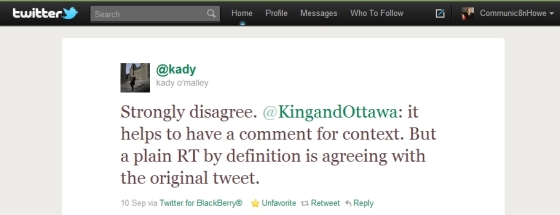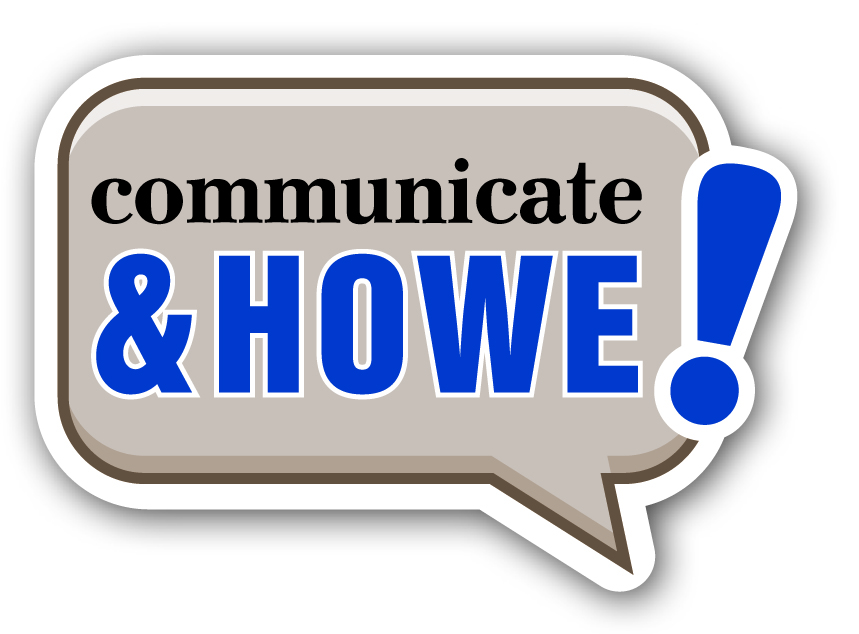I have always understood that a retweet on Twitter means that you agree with the original tweet. I discovered recently that not everyone agrees-a practice that I believe to be risky.
Using my personal account, I was clarifying with Ashley Csanady (@csanadyRecord) if she agreed with the politicians and activists she retweets. She said didn’t agree and retweeted a variety of parties and positions. Another person mentioned that many journalists did the same with tweets they found interesting. I mentioned that Kady O’Malley (@kady) could speak to how easy it was for a follower to believe they detected bias. That caught Kady’s attention and led to this exchange.
Kady’s response was retweeted by nine others and several people responded to me too. I was surprised by the number of people who considered a retweet to simply be sharing something interesting and that it didn’t mean that you agreed with the original tweet.
Maybe journalists who frequently retweet many different perspectives can do so without being personally connected to the original content, maybe. But it’s a not a practice I recommend for anyone else.
Types of retweets
I’ll explain why but first I would like to quickly review the three types of retweets so that you know when you’re seeing one.
New Retweet - If you retweet from Twitter.com or choose to use the new retweet in the program you use, it shares the tweet with your followers without any opportunity for you to comment. A retweet symbol shows who shared the original tweet. I’ll use this method only if I agree with the original one.
Original Retweet - At one time, if you wanted to retweet it was a completely manual cut and paste process. Using “RT” indicated that you were resending a tweet and you included the name of the user who said it first. Later this process was automated by tools like Tweetdeck. Many people still prefer the original retweet because it allows you to add a comment before or after what you are resending. I prefer this method.
Quote a Tweet - On Twitter for Blackberry, you have the option to quote a tweet and put your comments outside of the quotation marks. I’ll use this method but don’t prefer it.
By definition a plain RT agrees with the original tweet
Think about it. If all I see is a retweet sent from your twitter account, it looks to me that you are sending it because it says something you want to say-maybe even better than you could say it yourself. In short, I see a retweet as indicating that they took the words right out of your mouth.
How am I to know any differently? I can’t read your mind to know that you think it’s amusing or that you think the person who sent the original tweet is an idiot. I may not follow you closely enough to see the other tweets/retweets you send that show your own position so I don’t have any clues that what you retweeted doesn’t reflect your thoughts.
Other people may see what you retweeted through a search or someone may capture just that one tweet to share, for example, in a blog post. People seeing it in these circumstances have no idea why you retweeted it. But they see your name attached to the content and it’s the norm to expect it reflects what you think.
If you don’t agree with what you retweet, do you want to take the chance that someone will think you agree with it?
Add comments to your retweets
I strongly encourage you to add comments to your retweets even when you agree with them. When you include a comment, you add value to the original. And social media is all about providing value to the others in your network.
A comment also allows you to give some context to why you are retweeting something. “Can you believe this?”, “my thoughts exactly” or “an interesting read” lets your followers know what you were thinking and why you are sharing something. It also avoids the potential for confusion if someone sees your retweet in isolation.
Your comment can go before “RT” which is what I prefer but it can also go after the original tweet with something like “/” to show where your comment starts.
Few rules in social media but many best practices
Not everyone will agree with me. Social media and how it is used tends to be unique to the person using it. There are few rules that you must follow but there are best practices and I’m confident that what I’m sharing here is one.
At the same time, social media and how it is used is continually evolving. And there may be differences that are acceptable depending upon the hat you are wearing. For example, the conventions for journalists do seem to make retweeting without comment ok even if you don’t agree.
Kady and Ashley can continue to do so if they like but I won’t.
Next Social Media Breakfast features a journalist panel
What a retweet means is just one of the new considerations for journalists using social media. There are many others so the next Social Media Breakfast: Waterloo Region will have a several journalists on a panel to discuss how their job has changed with the rise of social media. They will also explore how social media has change media relations for the rest of us. It’ll be October 18 at the Kitchener Market.




James, good post. Like you, I almost always add my own comments to an RT to show why I am retweeting — that I think it’s funny, I agree, or found it moving, for instance. Rather than use the automatic RT, I will cut & paste just so I can comment, and shorten the original if I need room to do so.
I wouldn’t necessarily think an RT implies an *endorsement*, but you are right, just reposting without comment suggests that the person said it so well, you have nothing to add. Although even then, I would want to say something to that effect!
In the case of journalists retweeting politicians, it would be helpful to add “the NDP view” or whatever just to qualify it.
Thanks for sharing your thoughts Sue. I’m glad to hear that you, like many others who responded on Twitter, agree or mostly agree with me.
Just because Twitter is limited to 140 characters, I think we should share like we would when forwarding an e-mail or telling a friend they should watch a certain TV show. Rarely do we share something without explaining why which is part of the reason why I think a RT without a comment implies agreeing with it.
I read a post on the same subject today that suggests journalists use NT for a “neutral retweet” as a way to handle the same concerns I had about how some journalists retweet. Read it here: https://www.poynter.org/latest-news/media-lab/social-media/152448/the-problem-with-retweets-how-journalists-can-solve-it/#.Trkql4xXxo0.twitter